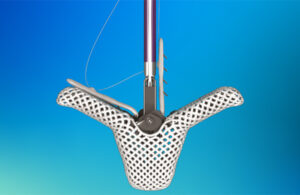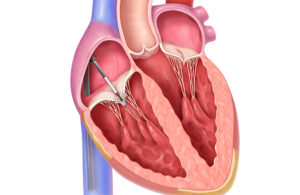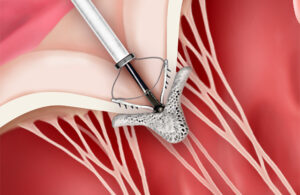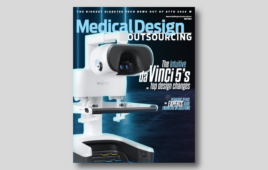
Nitinol components are crucial for the implantable heart valve clips used in Abbott’s TriClip and MitraClip systems.
Nitinol is a key material in the heart valve clips that Abbott designed for its TriClip and MitraClip transcatheter edge-to-edge repair (TEER) systems.
Abbott designed the TriClip system (approved by the FDA in April 2024) for reducing tricuspid valve regurgitation using fourth-generation heart valve clips that Abbott originally developed for the MitraClip transcatheter mitral valve repair (TMVr) system more than a decade ago.
Abbott turned to nitinol as a crucial design change from the first generation of that clip to improve its grip on the heart valve’s thin, flexible leaflets, said Santosh Prabhu, divisional VP of product development for Abbott’s structural heart business.
Nitinol frictional elements are an essential component of the heart clip’s grippers, he explained in an interview with Medical Design & Outsourcing.

This illustration shows the catheter-delivered TriClip implantation in the tricuspid valve. [Image courtesy of Abbott]
Rows of frictional elements along both grippers of the clip’s arms secure the leaflets without perforating them. The fourth-generation MitraClip NT and NTW have four rows of frictional elements, while the larger fourth-generation MitraClip XT and XTW have six rows.
Abbott made the first-generation clip’s frictional elements out of Elgiloy, a brand of super-alloy consisting mostly of cobalt, chromium and nickel, with lesser amounts of molybdenum, manganese, silicon, carbon, beryllium, phosphorus, sulfur and iron.
But that alloy lacked an important property that has made nitinol (a nearly equiatomic alloy of nickel and titanium) so popular among medical device developers, Prabhu said.
Elgiloy “was not superelastic, and therefore it wouldn’t drop all the way down,” he said. “But that was one of the major changes that we made when we came up with the second-generation clip, which is the MitraClip NT. The TriClip product is derived from the MitraClip product — all versions of the TriClip product have had the nitinol grippers.”
The clips themselves are made of cobalt-chromium and covered with polyester, a design meant to promote tissue growth and prevent thrombus formation.

This close-up of the illustration above shows the frictional elements on the clip’s grippers securing the tricuspid valve’s leaflets. [Image courtesy of Abbott]
Another important nitinol component is the leaf spring, which helps lock and unlock the clip.
“Again, it has to regain its original shape, and when you either lock the clip or unlock the clip, it has to deform and not undergo plastic deformation,” Prabhu said.

Santosh Prabhu is divisional VP of product development for Abbott’s structural heart business. [Photo courtesy of Abbott]
“Ten years later, laser technology was available to make some of those changes. [For] a lot of the things that we think we cannot do now, the technology might evolve,” Prahbu said.
Watch Medical Design & Outsourcing for more from our interview with Prabhu in the coming weeks.




![A photo of the Medtronic GI Genius ColonPro polyp detection system flagging a potential sign of colon cancer during a colonoscopy. [Photo courtesy of Medtronic]](https://www.medicaldesignandoutsourcing.com/wp-content/uploads/2024/04/Medtronic-GI-Genius-doctors-268x170.jpg)